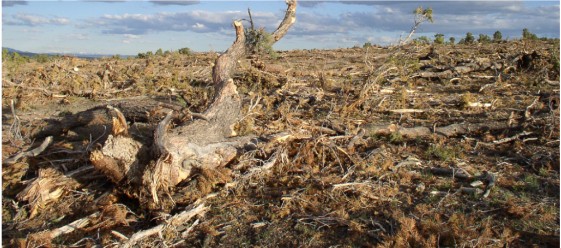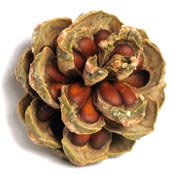Destroying millions of acres of pine nut groves in the Great Basin

Picture: Spruce Mountain, Nevada. Bureau of Land Management Chaining 2005.
The Destruction of Food Resources for man and beast
I: How did a native tree species become "invasive"?
Between the mid 1950s and 1973 more than 3 million acres of pinyon forests were converted to grasslands, generally under the auspices of "invading pinyon" myth - a theory developed to support the creation of grasslands for the cattle industry at tax payer expense.
Dr. Elbert Little began working in the pinyon system in the mid-1930's and two of his articles from 1977 and 1993 are in the packet . Dr. Littles study plots, as well as long term other study plots did not support any theory of expansion or invasion of the pinyon. I am certain you are familiar with basic pinyon ecology including the length of time which it takes (up to 125 years) for a tree pinon to become a mature seed producer. Also, the trees require shade and moisture to establish and cannot invade grasslands. P.monophylla seeds have only a 6 month seed viability window.
There has never been any major work done on documenting seed production cycles or examining the records of the pinon traders to determine the changes in the reproductive cycle of the tree. Additionally, beginning in 1964 the decline of pinyon jay, a primary seed disperser, began to decline at a rate of 4%.
If one reviews the body of literature on the pinyon system as a whole, it fairly easy to watch the evolution of poorly developed applied science. One of my favorite examples is the scientist from Los Alamos who discovered shade as a factor in watershed soils moisture after 20 year policy of pinyon removal justified as enhancing regional moisture through freeing up ground water. Another example is included: Vegetation differences in desert shrublands of western Utahâ??s Pine Valley between 1933 and 1989. I have also included other work done with long term study plots in the packet. None of this research supports the theory of an expansion of the pinyon system.
Additionally enclosed you will note that the reference number of pinyon system numbers in the mid 1970's is much greater than that currently used. The 1989, Analysis of Land Base Situated in the U.S. 1989, asserts about 47 million acres of pinyon-juniper. Jim Dobrowolski, cites pinyon-juniper rangelands as occupying more than 30 million acres. Additionally, airplane assessments collected on the pinyon die- off indicate tallied 1.9 million acres damaged in 2003 compared to 11.9 million acres were damaged in 2003. The 1950's drought impacted 490,000 acres in 1957. Records from the 1950's drought indicate that the pinon populations impacted were less than 100 years old and the species was not re - establishing well in the 19th and 20th century (Betancourt).
While popular theory was expanded biomass and competing weakening species resistance. Betancourt raised the question of water table and agriculture water use a possible contributor the pinyon die-off in the 1950's. It is my opinion that scientific community is failing to ask the right questions, because of the widely held acceptance "of pinyon invasions."
First hand accounts indicated that between 1993 and 2004 there had been no major seed harvest of P.edulis. There are no records of P. Monophylla harvests, other than auction sales records which are not reflective of actual harvests. Oral histories of Native American seed collectors would represent the best potential resource for determining changes to the reproductive patterns of the pinyon. It is very difficult for a species to invade when it is not reproducing well. This further supported by the work done on climate
I would like to understand the scope of change created by land use priorities. Are you aware of any survey done, which addressees pinyon acres treated from 1973 forward, including fuels reductions, chaining maintenance (it was common to double or triple the original treated areas under a maintenance plan), wild life enhancement (nuts are a major wild life food resource, yet, many plans have removed trees in order to enhance grasslands under the guise of wildlife improvement), watershed improvement, prescribed burns or other nomenclature? How could these trees be invading when their life-cycle indicates it is not even possible for them to have recovered from these massive deforestation projects?
Rething Training and FIelds OF Study:
In the Pinyon Juniper Woodlands, Elbert Little 1977
Walnut Canyon Pinyon plot 1937 -1977 - no show increased numbers of trees. 40 years field work no sign of pinon invading into grassland. Pinon cannot establish in grasslands, needs nurse trees and moisture. Pinons require 75 - 100 years to become seed mature producing stock. Juniper possibly expanding due to livestock transportation of seeds. Observed seed production decline by conversions of the 1950's. No research done prior to wide scale conversions of 1950 - 1970's. Post WWII management became mon-culture and pinyon ranges were converted without scientific support.
Pinyon Juniper Woodland - Denis Austin
Twenty three year study plot:
No major changes to the areas or vegetation. 14 years no change in number P.edulis found.
Vegetation differences in desert shrublands of Western Utahâ??s Pine Valley between 1933 and 1989, York
46 Year Study plot
No introduction of pinyon into area.
Single juniper established, which was 400 m from the range of the juniper stand.
Note: This study came to my attention in that it was cited to support pinyon invasion and I wanted to see the methods in the study. Additionally, it is this was one of our commercially harvest regions for pinyon pine nuts 2005.
Managing Southwestern Pinon -Juniper Woodlands: "The past half century and the Future" Elbert Little
Pinon eradication changed harvest dynamics and reproduction. Best sites for pinyon nuts converted (comment- better soils, converted for grasslands). Converted landscapes were trees 100 - 200 years old not invaders, unscientific work.
Failure of public land managers to manage pinyon resource.
My Vision of Pinon Socieconomic Potential of Pinon Woodland, Kline
CULTURE AND LAND USE POLICY - PLEASE REVIEW IN FULL
P- J Commercial Potential, Van Hooser
Notes survey done on agency management of pinyon woodland products.
Documents failure to manage and monitor the pine nut/woodland resource.
Influence of History and Climate on New Mexico Pinon-Woodlands, Betancourt
Recounts major seed production years and demonstrates through study of 1950's drought that pinon were not expanding due to poor seed establishment. Written pre- 2000 die off but suggests lowered water tables/agriculture land use may impact pinyon during drought.
Conversion of pinyon-juniper woodland to shrubland or herb-dominated
vegetation following wildfires in Mesa Verde National Park, Colorado, USA.
Romme, William*,1, Floyd-Hanna, Lisa2, Hanna, David2, 1 Colorado State
University, Fort Collins, CO2 Prescott College, Prescott, AZ
Pinyon (Pinus edulis) and juniper (Juniperus osteosperma) both have failed to reestablish within these burned areas, even where the fire occurred as long ago as 1934.
Pinyon-juniper woodland, which covered approximately half of Mesa Verde National Park in 1906, is now restricted to less than 25 % of the park area. The biological reasons for failure of
pinyon and juniper to reestablish after severe fires of the past century are unknown.




